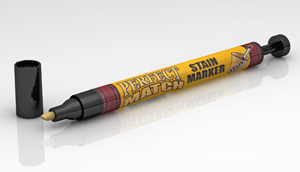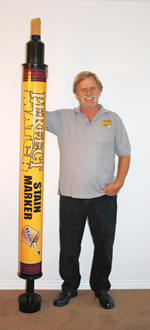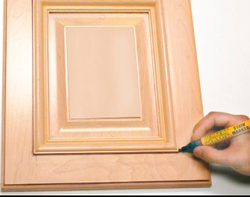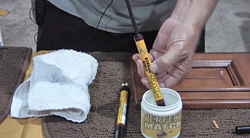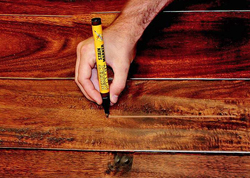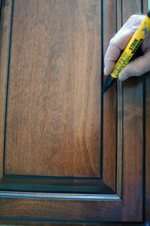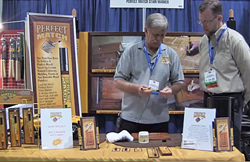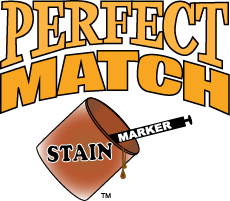
Naysayers might believe that there isn’t much new under the sun, but for an enterprising inventor like Harry Bainbridge, there’s always room to take a good product or idea and make it even better. He says he “just doesn’t stop” when there’s something on his mind that he wants to build. And the drive to solve a problem is probably at the heart of it all.
It certainly was the motivation behind Harry’s first patented invention: a refillable wood stain marker that loads fluid like a syringe and dispenses just the right amount of finish for fine touch-ups or detailing. Called “Perfect Match,” the marker will accept any water-, lacquer- or oil-based stain you choose. It’s only been available for a few years, but Harry says he’s sold more than 300,000 of them already.
“I ran my own cabinet shop for 25 years, so I know all the finishing options and processes,” Bainbridge says. One of the final items on a typical punch list for a cabinet installation is to touch up any blemishes in the stain. The usual method is to use disposable stain markers, which have been around for a long time. Most installers carry a selection of marker colors in their truck. But on one pivotal day about four years ago, Harry and his son-in-law, Tim, didn’t have the right color marker on hand. The custom stain they had created for the job was in a can back in the shop.
“This had happened to us before,” Harry recalls, “but Tim and I realized then and there that we should come up with a better solution than those throwaway markers.”
The two also reasoned that if they could create a refillable alternative, it not only would make for a convenient way to carry a small amount of custom color stains to any jobsite, but it also would be a helpful thing to leave behind with customers so they could touch up dings and scratches in their cabinets any time they needed to.
When Harry and Tim got back to the shop, the first order of business was to cut the backs off of a few of their aluminum-tube markers and try to figure out how they worked. Harry fashioned a plunger from a wooden dowel and cut three grooves into it for rubber O-rings. The goal was to create a syringe-style plunger that could form a seal inside the marker body. Pull it back, they speculated, and the vacuum created by the plunger would draw stain through the marker’s tip. It didn’t work. Only a small amount of stain ended up inside. More investigation showed them that actually, a spring and valve behind the marker’s felt tip is what allows stain to dispense and then stop flowing when the tip is released. It took about four more handmade versions of a marker, Harry recalls, and lots of experimentation with different spring options and plungers, before he and Tim landed on just the right solution.
“We finally were able to fill the marker with stain by placing the valve end into it and pulling the plunger back, creating the right amount of suction to fill the tube,” Harry recalls. The spring/valve combination is the “critical balance,” Harry says, between fluid dispensing during use, stopping when needed, and the ability to refill the marker again. Now with the major functional issues resolved, the two found a machinist who could make them one final prototype. It also worked as designed.
It was time to track down a manufacturer. That proved to be a greater challenge than Harry could have anticipated. First, his efforts to find a U.S.-based pen manufacturer who might be interested in making his invention proved futile. “I had no idea you can’t buy a pen made in America anymore,” Harry laments. A marker manufacturer in China was willing to take a closer look, but convincing the company engineers that his refillable marker actually worked took persuading. Harry says he and Tim had to explain in great detail every aspect of the marker’s design and demonstrate it to them before the company would believe the prototype had merit. They finally agreed to proceed with production.
In the end, persistence prevailed, buoyed by Harry’s checkbook. Six months later, and after spending around $70,000 to $80,000 in molds plus other manufacturing costs, he received the first shipment of Perfect Match Stain Markers from the manufacturer.
During this interim, and certain that he had an invention with promise, Harry and Tim initiated the patenting process. Tim first did an exhaustive Internet search for other patents on refillable markers, while Harry found a local patent attorney who could help them navigate the complex process of applying for patent.
“Did you know that every aspect of a new invention has to be free of other patents? You can’t take one part of a product, combine it with something from another product and consider that something new. I had no idea at the time,” Harry recalls. “You also have to prove that your product is unique and different from any other patented product that’s even remotely close to yours.”
The patenting process took two years and around $5,000 in legal costs. Twice, the concept had to be resubmitted to clarify additional aspects of the design, but Bainbridge finally received his patent in January 2012. “My attorney told me that only about five percent of the products submitted for patent ever receive one. Now that I’ve been through the whole process, I can see why.”
While he waited for patent approval, Harry didn’t rest on his laurels. He took a load of markers to the 2010 International Woodworking Fair in Atlanta, rented a booth and sold 3,000 of them to attendees over the course of just three days. The response was, in Harry’s estimation, overwhelmingly positive. His biggest fear, in retrospect, was that if his patent hadn’t gotten approved, the basic design could have been “scooped” by a competitor. Fortunately for Harry, that didn’t happen.
Unveiling Perfect Match Stain Markers at IWF attracted the attention of Bainbridge’s first national distributor: E. B. Bradley, a West Coast-based supplier of specialty hardware and surfacing products for the cabinetry industry. Over the three years that have followed since, Harry has expanded distribution to several hundred companies and cabinet shops that use the markers or provide them to their customers as a service. He sells markers to a few companies that also use them under private label.
Bainbridge says his refillable markers are used in the industry to highlight the details on cabinet doors and other architectural features. It’s much faster than highlighting by hand. They’ve also found favor with hobbyists who use them to color miniature furniture for dollhouses and other projects. The automotive industry was another potential outlet, but auto finishes dry too rapidly to store well in a refillable marker. Harry is pleased with his slowly growing customer base, but he says refillable markers “just aren’t a high volume item.”
Surely, every aspiring inventor who pursues a product idea far enough to patent and manufacture it feels the financial brunt of the process. Bainbridge has invested more than $300,000 in Perfect Match, and even now he hasn’t completely recouped his costs. But, that day is coming. “You don’t become a millionaire overnight,” Bainbridge adds, “despite what some people think.”
By the same token, nothing ventured, nothing gained. That was advice offered by Harry’s father-in-law, an entrepreneur who created a hinge-making business that provided Las Vegas with most of the hinge hardware for its slot machines. “Sometimes, you just have to go for it,” he told me at one point, “and I took that to heart … But one thing is for sure: you’ve got to put your time in to make it work.”
